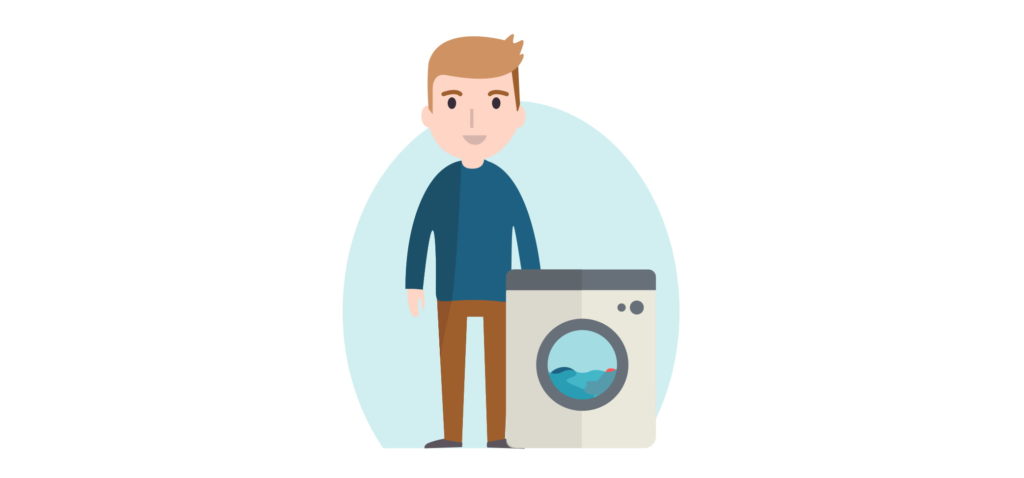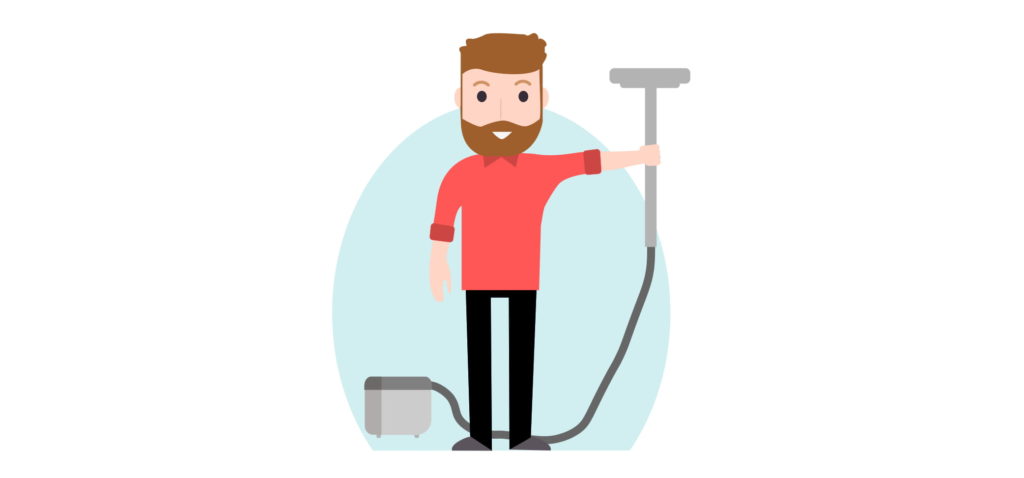Adult fleas, the kind you’d usually find living on your dog, only make up around 1-5% of an infestation, which means that for every adult flea you find, there’s at least another 95 fleas in other stages of development in your home. It’s time to address that other 95% and examine the best methods to rid your house of fleas.
When tackling a flea infestation it’s best to have a plan for how you’re going to rid the fleas from all areas you suspect those little pests may have hidden themselves; it takes a little preparation work so you can clean all of these areas in one go. That might mean making sure your dog and children are being cared for while you concentrate on the task or clearing your house of fleas.
If you’ve discovered fleas in your dog’s hair, this will mean you’ll need to clean any soft furnishings that your dog may have come into contact with, including bedding, carpets and rugs, since it’s likely that eggs have fallen from your dog and into areas your dog has recently been in your home.
1. Wash your bed sheets and other soft furnishings

Start by cleaning each room in your house top to bottom. For example, if you are planning to wash curtains, cushions and sofa coverings, it’s a good idea to start with those, then tackle the carpets and floors last. If you approach your cleaning in reverse (carpets then cushions and sheets) you risk dislodging eggs, larvae and pupae all over your newly cleaned floor.
Even if you’re not the type of dog owner that lets your dog sleep in your bed with you, it’s entirely possible that your bed may have become a breeding ground for fleas, too.
Here are our tips on washing sheets, cushions and your dog’s bed:
- Wash cushion covers, bed sheets and your dog’s bed on a hot cycle in the washing machine – it’s important to use a high temperature as water alone won’t kill the fleas.
- In extreme flea infestations, you may need to wash upholstery such as sofa cushions and pillows, too. If they can’t be washed at home, seal them in a plastic bag and get them cleaned at a dry cleaner or another professional cleaning service.
- In extreme cases, it might be best to throw away your dog’s bed and replace it – we hope it doesn’t come to that, though!
2. Vacuum and spray your carpets

Flea sprays contain a growth regulation chemicals known as Pyriproxyfen or Methoprene. Applying this to your carpets and other soft furnishings will drastically reduce the chances of eggs from hatching and larvae developing into pupae.
Vacuuming will reduce flea population in the pupate phase by around 64%.
Here’s the best vacuuming process to follow:
- Remove your dog, other pets and children from each room as you methodically clean around your house.
- Before applying spray to your carpet, begin with a preliminary vacuum. Where possible, move furniture – including sofas – to get access to all areas. The movement and vibrations, plus the hoovering itself, should help to open the fibres of your carpets and alert any pre-emerged flea pupae that a potential host is nearby. During this initial clean a significant proportion of the early-stage flea population will be killed and removed.
- Opinion is divided over whether you should immediately throw away the vacuum bag; if in doubt, you might as well remove the contents of your vacuum cleaner to an external bin. Most vacuums will kill or cause fatal damage to a large percentage of pupae and adult fleas, but in case any eggs survived the ordeal, you might as well remove the resulting dirt from your house!
- Next, apply the spray. It’s best to apply in short, 4 second-bursts in a cross shape to adequately cover roughly a one-square metre area of carpet.
- Leave windows open to ventilate and don’t allow children or dogs to re-enter the treated room for at least an hour.
3. Clean your hardwood and laminate floors
Even if you don’t have any carpets or rugs in your home, or even in every room of your home, it’s important to remember that cracks between floorboards and skirting boards provide the perfect shelter for flea eggs and larvae to hide.
To properly clean any hard or laminate floor surfaces in your house, you’ll need to follow a similar set of steps to cleaning a carpet:
- Ensure your dog has been treated (see our above guide on removing fleas from your dog) and is in another room of the house for the duration of your clean.
- Don’t start with spray or a mop – vacuum first! This has the same effect as with a carpet – hopefully you’ll rouse any dormant fleas and suck up any eggs before applying a spray.
- Use a vet recommended flea-killing flea spray in short, 4 second bursts in cross shapes at a distance of about 30 cm from the floor. Pay particular attention to the edges of the room. Alternatively, or additionally, if your home has had a particularly bad infestation of fleas, you could use a flea fogger. See below for a step by step guide for how to use one of these.
- After applying the flea spray, be sure to wait at least an hour before letting children and pets back into the room and keep the room well ventilated.
How to use a flea fogger
Flea foggers, sometimes called flea bombs, are an aerosol canister containing insecticide that can be set off in your home. The preparation for using one of these is a rather lengthy process and general advice states that your family and pets shouldn’t return to the room for several hours after using.
What’s more, they aren’t designed to be a catch-all solution to getting rid of fleas; for example, even though flea foggers disperse throughout the room, they won’t treat those harder to reach areas like underneath sofas and in the fibres of carpets – which, as we know, is where the majority of fleas will be hidden. All things considered you may be better off using a flea spray directly on your floors and carpets, since these are the areas fleas are likely to be hiding; this will also be less disruptive to your family!
However, if your household flea infestation is particularly bad; you’ve used other methods and have still found fleas in your home, you may want to use this method.
Here’s the step by step guide to using a flea fogger:
Preparing your home for a flea fogger is a detailed process and it’s important to follow the steps.
- Remove your children and dog from the room that you wish to treat. If you’re treating the entire house at once, you may need to find somewhere else to stay for a day – which makes this a less than ideal and more labour intensive option than spraying and vacuuming.
- Unplug any electrical appliances – foggers can be flammable and shouldn’t be left completely unattended.
- Cover or put away any food in airtight containers.
- Ensure you have a face mask handy if you’re going to be in the immediate vicinity while the fogger is going off.
- Vacuum the carpets in the room which will encourage some pupae to emerge – you will then kill these.
- Place a sheet of newspaper in the middle of the room and place the flea fogger on to the sheet of newspaper. Set off the bomb or fogger.
- Afterwards, open windows to ventilate and don’t allow children or pets back in the room for at least an hour.
Remember, always follow manufacturer’s instructions when using flea foggers or flea bombs.
4. Treat your garden to kill fleas

As we’ve already mentioned, the main entry point for fleas into your house is often through your garden – if you have one! Wild animals, and cats or other dogs, act as carriers and can spread a flea infestation.
What’s more, if you’ve discovered fleas on your dog, there’s a good chance that eggs will have fallen from your dog’s resident flea burden and into protected, shady area in your garden. That means there’s a good chance of your garden having a dormant flea population ready to strike again. They could even make their way indoors, so it’s best to make sure your entire home, including your garden, is flea-free.
How to prepare your garden for flea treatment
- Ensure your dog can be kept out of the garden during the treatment.
- Begin the preparation process with a thorough clean. It’s a good idea to remove any debris such as fallen leaves, grass clippings. Give it a good rake!
- If your lawn has become overgrown, give it a cut and be sure to dispose of the cuttings properly – don’t simply add them to a compost heap in your garden as this would provide an idea breeding ground for any fleas your grass mowing will have collected. Mowing may also help to encourage any pupae to emerge – since neither insecticide nor IGR (Insect Growth Regulator) can penetrate pupae cocoons.
- Check around cracks and crevices such as any brickwork or stones you might have lying around – for example, if you have a raised flower bed with brick or wooden beams this would be an ideal location for fleas larvae to hide out. Make sure you strim around the edges of your lawn, any paths and flowerbeds.
- Now that your garden is nice and tidy, you’re ready to apply the insecticide to kill or hamper the development of any early stage fleas.
Choosing the right product to remove fleas in your garden
Broadly speaking, there are two main types of flea-killing products out there; insecticides and Insect Growth Regulators. As the names suggest, they are effective at targeting different stages of the flea life cycle.
Insecticides: usually containing a chemical called Permethrin, these are effective at killing any adult fleas.
Insect Growth Regulators: contain Pyriproxyfen, Methoprene, Hydroprene or similar chemicals, which prevent fleas from successfully molting. They are effective at killing larvae, can reduce the fertility of eggs and be effective in disrupting diapause – which is when adults enter a dormant state in cocoons.
It may be necessary to use both types of product; we’d recommend tackling any adult fleas with insecticide first as these are the stage which presents an immediate threat to your dog. If the infestation is severe, you may need to use an IGR, too. In some cases, you can mix the two together and treat your garden in one go. It’s worth checking with your vet or local garden centre on the best method and product combinations.
Pupae are largely immune to chemical treatments because their cocoons are watertight, we’d recommend that you repeat treatments in your garden every one to two weeks. What’s more, not all fleas in your garden or home develop simultaneously. This means you can expect an infestation to hatch, molt and emerge from cocoons at different times. It’s important to manage your expectations and to schedule a second, and even third, treatment in week intervals to properly deal with all fleas.
The best product for you will depend greatly on the size of your garden; if you have a large garden there are professional spray tools you can use to distribute your insecticide across your garden evenly. Remember to follow the manufacturer’s instructions to ensure you use the right amounts.
How to use an insecticide or IGR to get rid of fleas in your garden
- Purchase, hire or borrow a hose end sprayer. You can pick one up online for less than £10. This will be helpful in distributing an even application of the insecticide or IGR solution. You could also use a watering can, but a hose end sprayer will give you more even coverage.
- Ensure you are using an IGR that’s suitable for outdoor use; some products are not photostable (in direct sunlight will cease to work).
- Fill the sprayer with the correct ratio of water and your chosen product – check the manufacturer’s instructions as the amount you will need to use may vary.
- Spray across your garden, including the lawn and around any cracks in patios, paths and flowerbeds.
- Ensure your dog keeps away from the garden for at least an hour, or until the surfaces are dry.
- Repeat within 10-14 days as needed.
Natural ways to get rid of fleas in your house
We’d always recommend using vet-approved products, but there are other options out there. Please note that while these methods have seen some success, the best, fastest and most effective way to remove fleas from your house and garden is by using insecticides and IGRs.
However, if you prefer to use alternative methods, we’ve listed some of them here.
Sprinkle salt on carpets
Similar to using a flea powder or diatomaceous earth, this method relies on sprinkling salt into your carpet and other furnishings and then vacuuming it up again at least 24 hours later.
The theory is that a fine salt will dry out any flea life stages but the main problem with this method is that you have to wait a very long time before vacuuming the salt back up again, and you should prevent your dog from getting near the salt as it’s not good for dogs!
How to use a homemade vinegar spray
Using one part vinegar and one part water solution into an empty, clean spray bottle. Mix the solution and spray onto carpets.
This solution is very limited since fleas reportedly don’t like the smell of vinegar, but carpets are where immature fleas are most likely to be hiding, so you’re probably better off skipping this method and using an Insect Growth Regulator and regular vacuuming to eliminate early life cycle stage fleas from your home.
Use food grade diatomaceous earth
Diatomaceous earth is a natural substance that many people claim can be used as an all-round household wonder-product. It’s made from the soft sedimentary rock which are the fossilised remains of algae. Purchase a food grade version so as not to harm any pets or people in your home.
It can be used by sprinkling on pre-vacuumed carpets; when fleas come into contact with the dust, they’ll dehydrate and die. For best results, leave the diatomaceous earth on your carpet for three days so that it continues to kill fleas. Then simply vacuum it up!
However, since the flea stage present in your carpets and other furnishings are mostly eggs, larvae and pupae, you may be better off using an Insect Growth Regulator and a simple vacuum cleaner and repeating the process regularly.
For tips on how to prevent fleas from reappearing in your house and garden, check out our article which will walk you through it step by step.